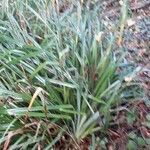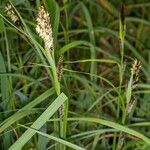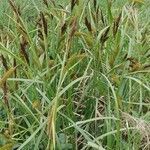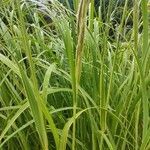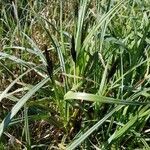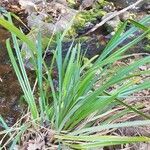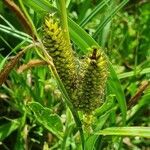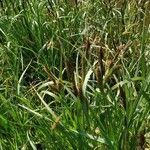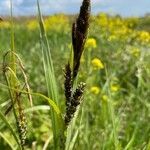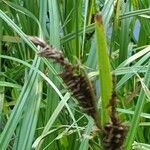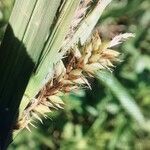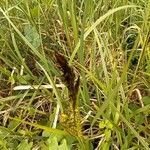Rhizome stout. Culms 60-150 cm tall, triquetrous, scabrous on upper part, clothed with brown or reddish brown sheaths at base. Leaves equaling or longer than culm, blades 10-15 mm wide, flat, ± stiff, with distinct and transverse septate nodes between veins, rather long sheathed. Involucral bracts leafy, lowermost involucral bract longer than inflorescence, nearly not sheathed or lower involucral bracts shortly sheathed. Spikes 5-10, lower spikes remote and upper spikes approximate; terminal 3-6 spikes male, oblong-cylindric or cylindric, 2-6 cm, subsessile; remaining spikes female, cylindric, 3-6 × ca. 1 cm, densely many flowered, sometimes with male flowers at top, upper spikes subsessile, lower spikes slightly long pedunculate. Female glumes brown, lanceolate, ca. 6 mm, 3-veined, apical margins hispidulous, apex acuminate, mucronate. Utricles fuscous-green, obliquely patent, nearly equaling glume, elliptic-ovate, obtusely trigonous, 5-6 mm, leathery or slightly corky, glabrous, several veined, base cuneate, apex gradually narrowed to a slightly broad and short beak, orifice slightly divergent and shortly 2-toothed. Nutlets rather loosely enveloped, obovate, trigonous, slightly concave on 3 sides; style stiff, persistent, base not thickened; stigmas 3. Fl. and fr. May-Jun.
More
Tufted, to 90 cm high. Rhizome far-extending, stout with fibrous grey-brown scales. Stems sharply 3-angled, scabrid on angles just below inflorescence. Leaves > stems, to 15 mm wide, rigid, erect, channelled to double-folded, blue-green, minute cross-veinlets very distinct when dry; sheaths very long, bright reddish to whitish, distinctly septate-nodulose. Inflorescence with longer, narrow, leaf-like bracts below; spikes numerous, erect, brown. Male spikes 3-4, crowded, 2-6 cm × 5-10 mm, tapered above to a point; glumes very narrow-lanceolate, acuminate or with excurrent midrib. Female spikes 2-4, occasionally male at top, 6-11 × 1-1.2 cm, fusiform, upper sessile, lower pedunculate; glumes > utricles, lanceolate with midrib long-excurrent. Utricles 5-5.5 × 2 mm, with numerous fine nerves, glabrous, dull grey-brown, subtrigonous, ovate, gradually tapered to a bifid beak ± 1 mm long. Stigmas 3. Nut oblong-ovoid, trigonous, shortly stipitate.
A sedge. These grow in clumps and have grass like leaves and solid stalks. It is a coarse plant. It grows 150 cm high. The stems are triangle in cross section. The leaf blades have a deep midrib. The flowers are of one sex. The upper flowers are male and the lower flowers are female.
Typically found on the margins of base-rich, mesotrophic to eutrophic rivers, streams, lakes and canals, in marshes and in fens., often forming extensive mono-specific swards, but will also occur as a narrow fringe on linear water bodies.
More
It grows in bog areas of cold temperate regions.
